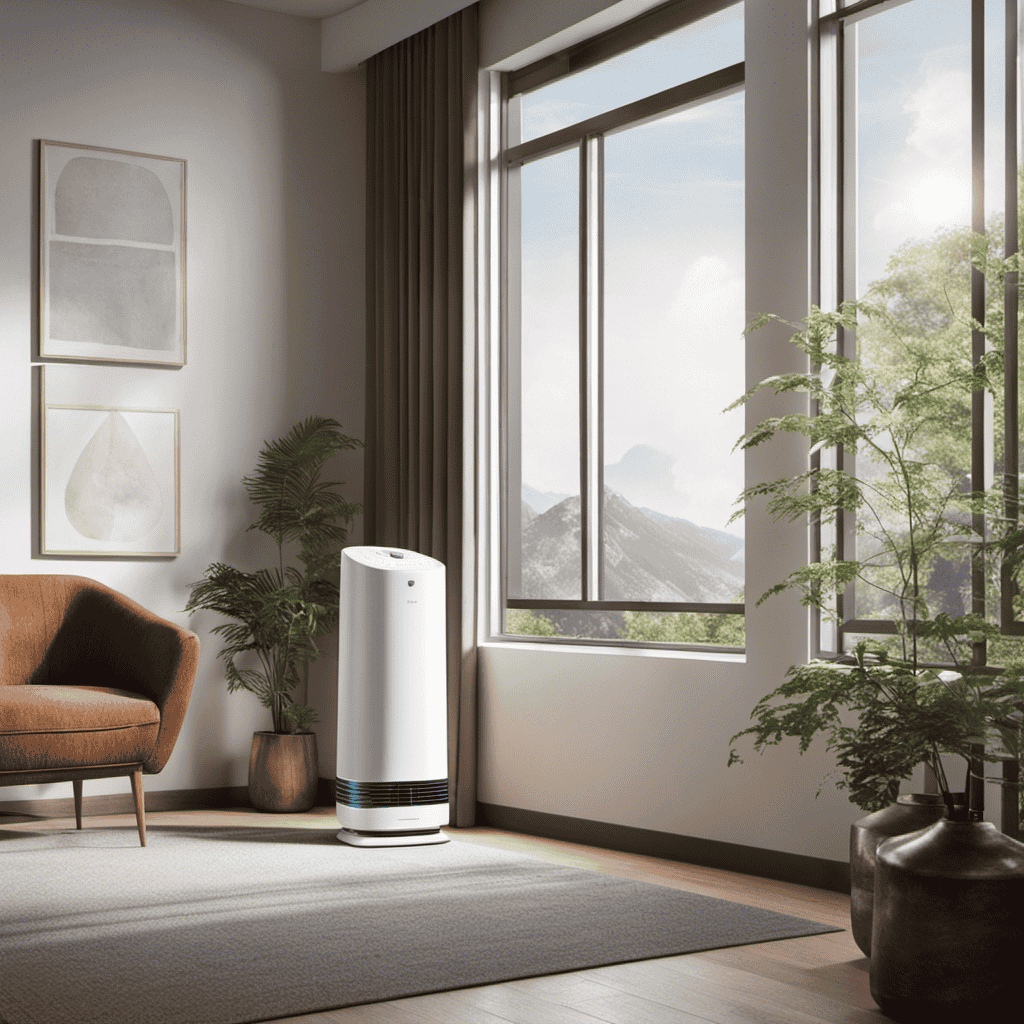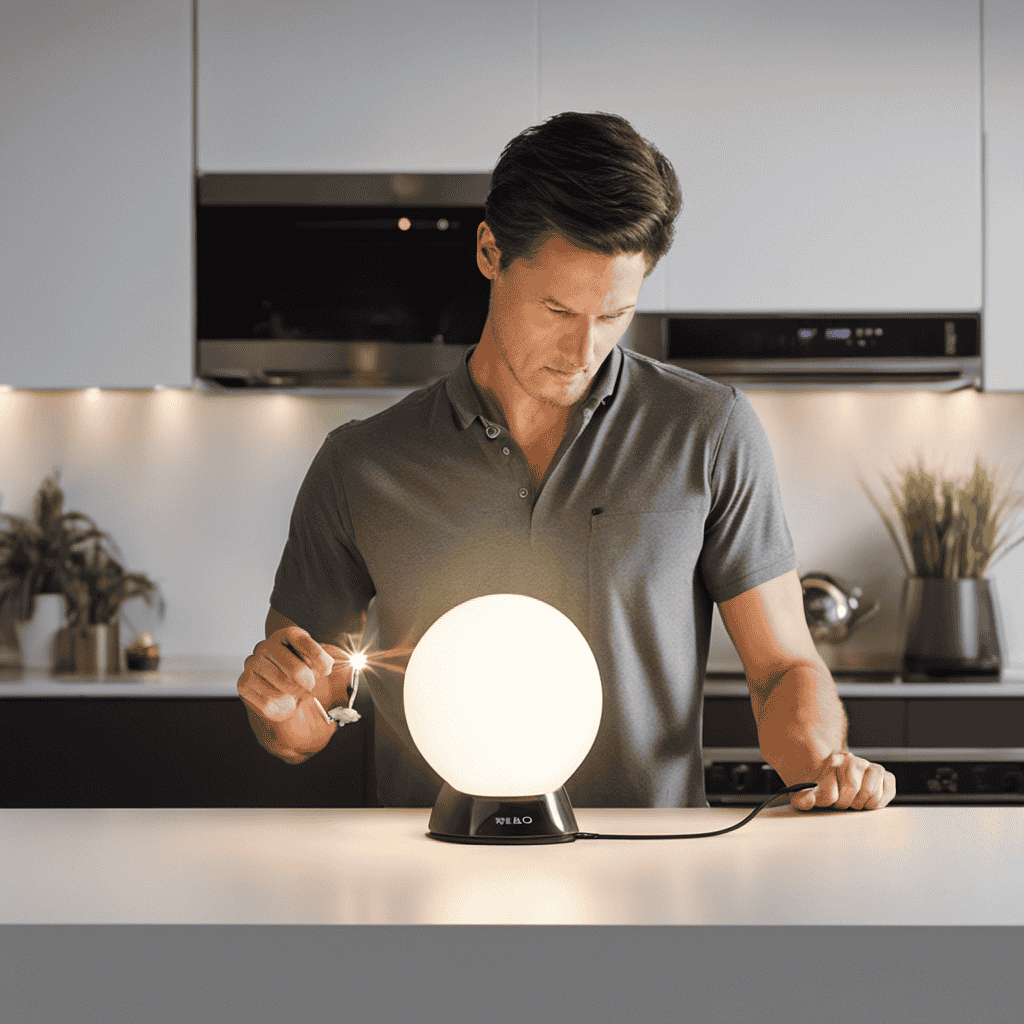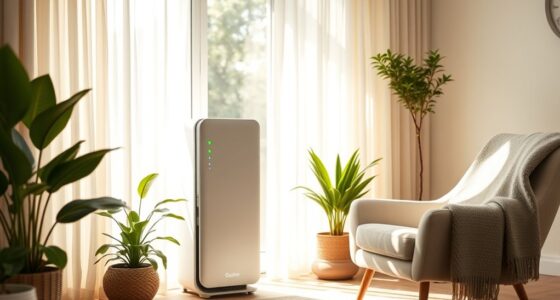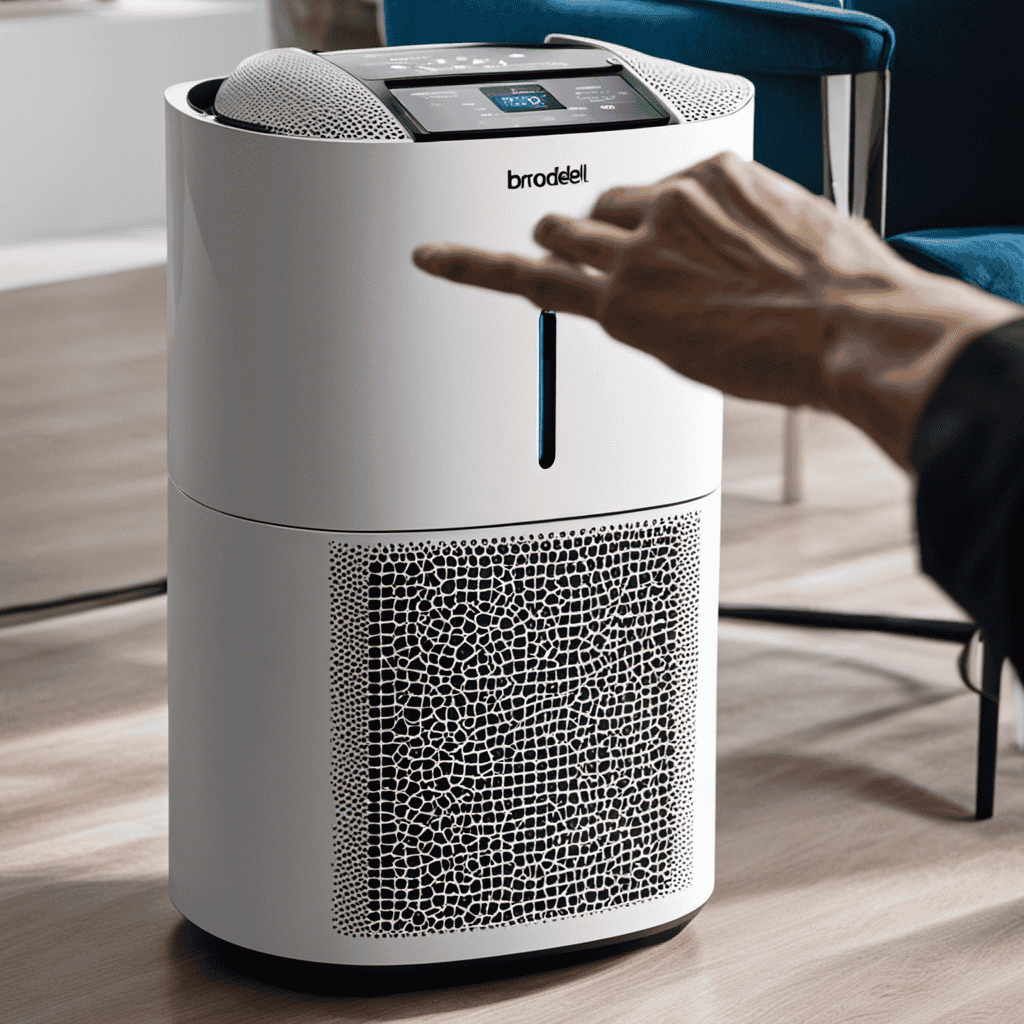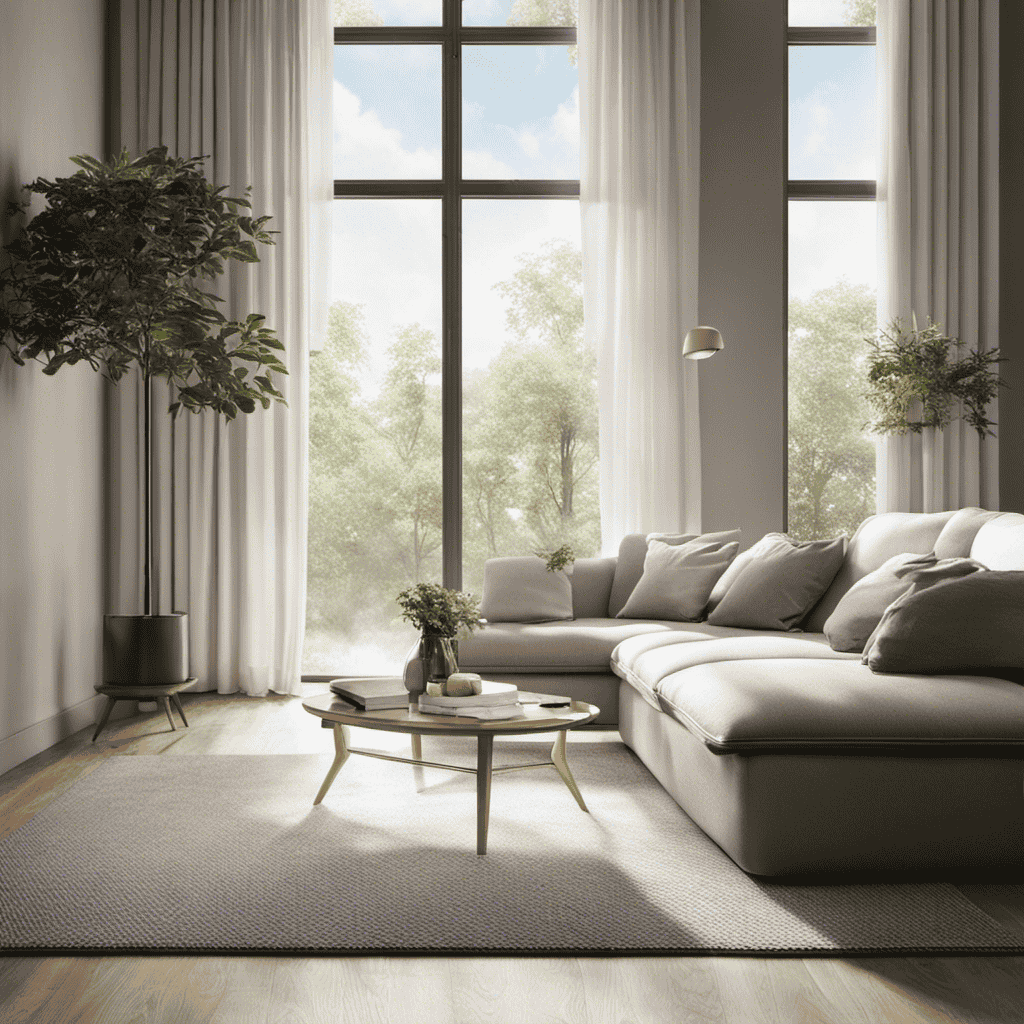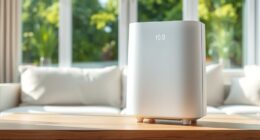I have often pondered the workings of room air purifiers. Let me say, it’s truly intriguing. These handy gadgets utilize sophisticated filtration systems to eliminate air pollutants.
With key components like filters and fans, they effectively trap and eliminate harmful particles, leaving us with cleaner and healthier air. And the best part? Using a room air purifier comes with a range of benefits that can greatly improve our overall well-being.
So, let’s dive into the science behind these air-cleaning marvels!
Key Takeaways
- Room air purifiers improve indoor air quality by removing pollutants and contaminants.
- The main components of an air purifier are filters and a fan.
- Different types of filters have unique capabilities in removing specific pollutants, such as HEPA filters being highly efficient at capturing small particles and activated carbon filters effectively trapping odors, gases, and volatile organic compounds (VOCs).
- Regular maintenance, including cleaning or replacing filters, is crucial for optimal performance and efficient pollutant removal.
The Science Behind Room Air Purifiers
The science behind how room air purifiers work is fascinating. These devices are designed to improve indoor air quality by removing pollutants and contaminants from the air.
The main components of an air purifier are the filters and the fan. As the fan draws air into the purifier, it passes through the filters, which capture particles such as dust, pollen, pet dander, and smoke. The filters use a combination of physical and chemical processes to trap and remove these particles.
Regular air purifier maintenance is essential to ensure optimal performance. This includes cleaning or replacing the filters regularly and keeping the purifier in a clean environment.
Understanding Air Filtration Systems
To better understand how air filtration systems work, you should know that they use filters to trap and remove contaminants from the air.
Air purifiers are designed to improve indoor air quality by removing common air pollutants such as dust, pollen, pet dander, mold spores, and even harmful gases. These pollutants can cause allergies, respiratory issues, and other health problems.
Regular air purifier maintenance is crucial to ensure optimal performance. This includes cleaning or replacing filters regularly, as clogged filters can reduce the efficiency of the system.
Additionally, it is important to vacuum and dust the surrounding area to prevent the accumulation of particles that could potentially bypass the filters.
Key Components of a Room Air Purifier
When it comes to air purification, understanding the different types of filters and their effectiveness is crucial.
From HEPA filters to activated carbon filters, each filter type has its own unique capabilities in removing specific pollutants from the air.
Additionally, exploring the various air purification technologies available can help us make informed decisions about which system is best suited for our specific needs and concerns.
Filter Types and Effectiveness
Different filter types in room air purifiers vary in their effectiveness at capturing and removing airborne particles. When it comes to air purifier maintenance, understanding the different filter types is essential.
The most common filter types used in room air purifiers include HEPA filters, activated carbon filters, and electrostatic filters. HEPA filters are highly efficient at capturing small particles, such as dust, pollen, pet dander, and mold spores. Activated carbon filters are effective at trapping odors, gases, and volatile organic compounds (VOCs). Electrostatic filters use an electric charge to attract and capture particles.
It is important to note that no single filter type can capture all types of common air pollutants. Therefore, it is recommended to choose an air purifier that uses a combination of filter types to effectively remove a wide range of airborne contaminants.
Regular filter replacement and cleaning are crucial for optimal performance and maintaining clean indoor air quality.
Air Purification Technologies
Understanding the various air purification technologies available can help you choose the most effective method for improving your indoor air quality.
There are several types of air purification technologies commonly used in room air purifiers. These include mechanical filtration, activated carbon filtration, ultraviolet germicidal irradiation, and photocatalytic oxidation.
Mechanical filtration is the most basic and widely used technology, which uses filters to physically trap particles and pollutants. Activated carbon filtration is effective at removing odors and gases. Ultraviolet germicidal irradiation uses UV light to kill bacteria, viruses, and other microorganisms. Photocatalytic oxidation uses a combination of UV light and titanium dioxide to break down pollutants.
To maintain the efficiency of your air purifier, regular maintenance is necessary, such as cleaning or replacing filters and cleaning the unit itself. By understanding these technologies and performing proper maintenance, you can ensure that your air purifier continues to effectively remove common air pollutants from your indoor environment.
In the next section, we will explore how room air purifiers remove pollutants using these technologies.
How Room Air Purifiers Remove Pollutants
When it comes to removing pollutants from the air, room air purifiers utilize various filtration mechanisms.
These mechanisms include the use of filters such as HEPA filters, activated carbon filters, and electrostatic filters. Each of these filters is designed to target specific types of pollutants and capture them effectively.
The efficiency of pollutant removal depends on the type and quality of the filters used, as well as the air purifier’s airflow rate and coverage area.
Filtration Mechanisms Used
To understand how a room air purifier works, you’ll want to know about the filtration mechanisms it uses. These mechanisms play a crucial role in purifying the air and improving indoor air quality.
Here are three important filtration mechanisms commonly used in room air purifiers:
-
Pre-filter: The pre-filter is the first line of defense against larger particles such as dust, pet dander, and pollen. It captures these particles, preventing them from entering the main filter.
-
HEPA filter: High-Efficiency Particulate Air (HEPA) filters are designed to remove 99.97% of airborne particles as small as 0.3 microns. They can effectively capture pollutants like smoke, mold spores, and bacteria, improving the overall air quality.
-
Activated carbon filter: Activated carbon filters are highly effective in removing odors, gases, and chemical fumes. The carbon particles in the filter attract and trap these molecules, leaving the air fresh and clean.
Understanding these filtration mechanisms is crucial for purifier maintenance and ensuring optimal air quality improvement.
Efficiency of Pollutant Removal
The efficiency of pollutant removal is enhanced by the combination of pre-filter, HEPA filter, and activated carbon filter in a room air purifier. Proper air purifier maintenance is essential to ensure optimal performance and pollutant removal efficiency.
Several factors can affect the efficiency of pollutant removal, including the quality and condition of the filters, the airflow rate, and the types and concentrations of pollutants present in the air. Regularly cleaning or replacing filters is crucial to maintain their effectiveness in capturing pollutants.
Additionally, factors such as the size, shape, and density of particles, as well as the contact time between the pollutants and the filters, can also impact the overall efficiency of pollutant removal.
Understanding these factors is key to maximizing the effectiveness of air purification systems and ensuring clean and healthy indoor air.
Now, let’s explore the role of filters in air purification.
The Role of Filters in Air Purification
Filters play a crucial role in air purification by trapping and removing harmful particles. Regular filter maintenance is essential to ensure the optimal performance of an air purifier. It is recommended to clean or replace the filters according to the manufacturer’s instructions. Neglecting filter maintenance can result in reduced efficiency and compromised air quality.
The lifespan of filters varies depending on factors such as the type of filter and the level of pollutants in the air. HEPA filters, for example, typically last around 6 to 12 months before they need replacement.
Some air purifiers come with filter replacement indicators, which notify users when it’s time to change the filters. By properly maintaining and replacing filters, we can maximize the effectiveness of our air purifiers and enjoy cleaner, healthier indoor air.
Transitioning into the benefits of using a room air purifier, let’s explore how it can improve our overall well-being.
Benefits of Using a Room Air Purifier
Now that we understand the role of filters in air purification, let’s explore the advantages and health benefits of using a room air purifier.
Room air purifiers offer several advantages that contribute to improved indoor air quality. Firstly, they effectively remove airborne pollutants such as dust, pollen, pet dander, and mold spores, reducing the risk of allergies and respiratory issues.
Additionally, air purifiers eliminate unpleasant odors, creating a fresh and clean environment. These devices also help in removing harmful volatile organic compounds (VOCs) emitted by household products and indoor pollutants like tobacco smoke.
Moreover, air purifiers can be particularly beneficial for individuals with asthma or other respiratory conditions, as they minimize exposure to triggers and provide relief.
Overall, incorporating a room air purifier into your living space can greatly enhance the quality of the air you breathe, promoting better health and well-being.
Frequently Asked Questions
How Often Should I Replace the Filters in My Room Air Purifier?
I replace the filters in my room air purifier every 3-6 months, depending on the manufacturer’s recommendations. Different types of air purifiers may have different filter replacement schedules, so it’s important to check the specific guidelines for your device.
Can Room Air Purifiers Remove Odors?
Yes, room air purifiers can remove odors. They work by filtering out airborne particles, including those that cause odors. This makes them a safer alternative to scented candles and pet-friendly.
Are Room Air Purifiers Effective in Reducing Allergens Like Pollen and Pet Dander?
Yes, room air purifiers are effective in reducing allergens like pollen and pet dander. Regular room air purifier maintenance ensures optimal performance. The benefits of using a room air purifier include cleaner air and improved respiratory health.
Can a Room Air Purifier Help With Respiratory Conditions Such as Asthma or Allergies?
Using a room air purifier for respiratory conditions like asthma or allergies has its pros and cons. It’s important to choose the right one for your needs. Let’s explore the benefits and considerations.
Do Room Air Purifiers Consume a Lot of Electricity?
Room air purifiers have varying energy efficiency levels, so their electricity consumption can differ. It’s important to consider the purifier’s wattage and the cost of operation to determine if it consumes a lot of electricity.
Conclusion
In conclusion, room air purifiers are truly the unsung heroes of clean air. They tirelessly work to eliminate pollutants, acting as the silent warriors in our battle for fresh and healthy indoor environments.
With their advanced filtration systems and intricate components, they act like vigilant guardians, trapping and removing harmful particles from the air we breathe.
Like a skilled surgeon, these purifiers delicately dissect and cleanse the air, providing us with a breath of relief.
So, let us embrace these purifiers, for they are the knights in shining armor, protecting us from invisible enemies.
